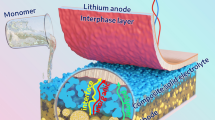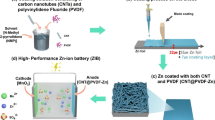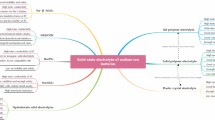Abstract
Flexible sodium-ion batteries (SIBs) have enormous potential in portable and wearable devices due to their suitability and price advantage in particular scenarios. Among the cathode materials, phosphate electrode materials have the advantage of good structural stability, high working potential and long lifespan. However, the design of flexible phosphates electrode materials is still a challenge due to hush fabrication requirements, complex reactions and absence of flexible substrates. Herein, we report the in-situ fabrication of three-dimensional sodium vanadium fluorophosphate nanorod array (PCNF@NVOPF NR) from vertically grown VO2 nanosheets on flexible porous carbon nanofibers. The PCNF@NVOPF NR as a flexible high-voltage cathode possesses long-term cycling stability (87.6% capacity retention after 4500 cycles). The nanorod arrays can ensure fast sodium reaction kinetics and low interfacial resistance. Moreover, PCNF@NVOPF//PCNF@VO2 NS@C full SIBs exhibit high energy and power density (220.5 W h kg−1 and 9400 W kg−1). This material design strategy for flexible cathode will inspire the commercialization of practical SIBs.

摘要
柔性钠离子电池(SIBs)在便携式和可穿戴设备中具有巨大的应用潜力, 因为它们在特定情况下具有适用性和价格优势. 在正极材料中, 磷酸盐电极材料具有结构稳定性好、 工作电位高和寿命长的优点. 然而, 由于对制造要求苛刻, 反应复杂, 以及柔性基材的缺失等问题, 柔性磷酸盐电极材料的设计仍然是一个巨大的挑战. 在此, 我们报道了在柔性多孔碳纳米纤维上垂直生长的VO2纳米片原位转化为三维氟磷酸钒钠纳米棒阵列(PCNF@NVOPF NR). PCNF@NVOPF NR实现了兼具柔性与高压正极电极的特点, 并具有长期循环稳定性(4500次循环后容量保持率为87.6%). 阵列结构可以确保快速的钠反应动力学和低界面电阻. 此外, PCNF@NVOPF NR//PCNF@VO2 NS@C钠离子全电池表现出高能量和功率密度(220.5 W h kg−1和9400 W kg−1). 这种用于柔性正极的材料设计策略可促进实用钠离子电池的商业化.
Similar content being viewed by others
References
Niu YB, Yin YX, Guo YG. Nonaqueous sodium-ion full cells: Status, strategies, and prospects. Small, 2019, 15: 1900233
Palomares V, Serras P, Villaluenga I, et al. Na-ion batteries, recent advances and present challenges to become low cost energy storage systems. Energy Environ Sci, 2012, 5: 5884–5901
Liang Y, Lai WH, Miao Z, et al. Nanocomposite materials for the sodium-ion battery: A review. Small, 2018, 14: 1702514
Thimmappa R, Gautam M, Aralekallu S, et al. A rechargeable aqueous sodium-ion battery. ChemElectroChem, 2019, 6: 2095–2099
Hasa I, Mariyappan S, Saurel D, et al. Challenges of today for Na-based batteries of the future: From materials to cell metrics. J Power Sources, 2021, 482: 228872
Wang L, Światowska J, Dai S, et al. Promises and challenges of alloy-type and conversion-type anode materials for sodium-ion batteries. Mater Today Energy, 2019, 11: 46–60
Wang J, Wang Z, Ni J, et al. Electrospinning for flexible sodium-ion batteries. Energy Storage Mater, 2022, 45: 704–719
Xu J, Chen J, Tao L, et al. Investigation of Na3V2(PO4)2O2F as a sodium ion battery cathode material: Influences of morphology and voltage window. Nano Energy, 2019, 60: 510–519
Mishra RK, Choi GJ, Sohn Y, et al. A novel RGO/N-RGO supercapacitor architecture for a wide voltage window, high energy density and long-life via voltage holding tests. Chem Commun, 2020, 56: 2893–2896
Yue L, Wang J, Li M, et al. Conductive Ti3C2Tx networks to optimize Na3V2O2(PO4)2F cathodes for improved rate capability and low-temperature operation. Dalton Trans, 2023, 52: 4717–4727
Hao ZL, Du M, Guo JZ, et al. Nanodesigns for Na3V2(PO4)3-based cathode in sodium-ion batteries: A topical review. Nanotechnology, 2023, 34: 202003
Ren W, Zheng Z, Xu C, et al. Self-sacrificed synthesis of three-dimensional Na3V2(PO4)3 nanofiber network for high-rate sodium-ion full batteries. Nano Energy, 2016, 25: 145–153
Luo W, Zhang P, Wang X, et al. Antimony nanoparticles anchored in three-dimensional carbon network as promising sodium-ion battery anode. J Power Sources, 2016, 304: 340–345
Hu X, Li Y, Zeng G, et al. Three-dimensional network architecture with hybrid nanocarbon composites supporting few-layer MoS2 for lithium and sodium storage. ACS Nano, 2018, 12: 1592–1602
Lü HY, Zhang XH, Wan F, et al. Flexible P-doped carbon cloth: Vacuum-sealed preparation and enhanced Na-storage properties as binder-free anode for sodium ion batteries. ACS Appl Mater Interfaces, 2017, 9: 12518–12527
Xu G, Tian Y, Wei X, et al. Free-standing electrodes composed of carbon-coated Li4Ti5O12 nanosheets and reduced graphene oxide for advanced sodium ion batteries. J Power Sources, 2017, 337: 180–188
Ruan J, Yuan T, Pang Y, et al. Nitrogen and sulfur dual-doped carbon films as flexible free-standing anodes for Li-ion and Na-ion batteries. Carbon, 2018, 126: 9–16
Ren W, Wang C, Lu L, et al. SnO2@Si core-shell nanowire arrays on carbon cloth as a flexible anode for Li ion batteries. J Mater Chem A, 2013, 1: 13433–13438
Bi R, Zeng C, Ma T, et al. Encapsulated hollow Na2Ti3O7 spheres in reduced graphene oxide films for flexible sodium-ion batteries. Electrochim Acta, 2018, 284: 287–293
Wang Y, Liu Y, Liu Y, et al. Recent advances in electrospun electrode materials for sodium-ion batteries. J Energy Chem, 2021, 54: 225–241
Wei Q, DeBlock RH, Butts DM, et al. Pseudocapacitive vanadium-based materials toward high-rate sodium-ion storage. Energy Environ Mater, 2020, 3: 221–234
Lee J, Park S, Park Y, et al. Chromium doping into NASiCON-structured Na3V2(PO4)3 cathode for high-power Na-ion batteries. Chem Eng J, 2021, 422: 130052
Ding H, He X, Tao Q, et al. N-doped carbon-layer-modified Na3V2(PO4)3 as a high-performance cathode material for sodium-ion batteries. Energy Fuels, 2022, 36: 10384–10394
Huang Q, Hu Z, Chen K, et al. Partial modification strategies of NASICON-type Na3V2(PO4)3 materials for cathodes of sodium-ion batteries: Progress and perspectives. ACS Appl Energy Mater, 2023, 6: 2657–2679
Liu Y, Li J, Shen Q, et al. Advanced characterizations and measurements for sodium-ion batteries with NASICON-type cathode materials. eScience, 2022, 2: 10–31
Aragón MJ, Lavela P, Alcántara R, et al. Effect of aluminum doping on carbon loaded Na3V2(PO4)3 as cathode material for sodium-ion batteries. Electrochim Acta, 2015, 180: 824–830
Hu F, Jiang X. Superior performance of carbon modified Na3V2(PO4)2F3 cathode material for sodium-ion batteries. InOrg Chem Commun, 2021, 129: 108653
Wu L, Dong S, Pang G, et al. Rocking-chair Na-ion hybrid capacitor: A high energy/power system based on Na3V2O2(PO4)2F@PEDOT core-shell nanorods. J Mater Chem A, 2019, 7: 1030–1037
Yan RB, Zhan GH, Liao WH, et al. Uniform Na3V2(PO4)O2F microcubes enhanced by ionic liquid-modified multi-walled carbon nanotubes as a superior cathode for sodium-ion batteries. Electrochim Acta, 2023, 439: 141671
Yin Y, Pei C, Liao X, et al. Revealing the multi-electron reaction mechanism of Na3V2O2(PO4)2F towards improved lithium storage. ChemSusChem, 2021, 14: 2984–2991
Li L, Xu Y, Sun X, et al. Fluorophosphates from solid-state synthesis and electrochemical ion exchange: NaVPO4F or Na3V2(PO4)2F3? Adv Energy Mater, 2018, 8: 1801064
Chang W, Zhang XY, Qu J, et al. Freestanding Na3V2O2(PO4)2F/graphene aerogels as high-performance cathodes of sodium-ion full batteries. ACS Appl Mater Interfaces, 2020, 12: 41419–41428
Xing S, Cheng Y, Yu F, et al. Na3(VO)2(PO4)2F nanocuboids/graphene hybrid materials as faradic electrode for extra-high desalination capacity. J Colloid Interface Sci, 2021, 598: 511–518
Chen Z, Augustyn V, Jia X, et al. High-performance sodium-ion pseudocapacitors based on hierarchically porous nanowire composites. ACS Nano, 2012, 6: 4319–4327
Zhao L, Rong X, Niu Y, et al. Ostwald ripening tailoring hierarchically porous Na3V2(PO4)2O2F hollow nanospheres for superior high-rate and ultrastable sodium ion storage. Small, 2020, 16: 2004925
Chao D, Lai CH, Liang P, et al. Sodium vanadium fluorophosphates (NVOPF) array cathode designed for high-rate full sodium ion storage device. Adv Energy Mater, 2018, 8: 1800058
Jian Z, Han W, Lu X, et al. Superior electrochemical performance and storage mechanism of Na3V2(PO4)3 cathode for room-temperature sodium-ion batteries. Adv Energy Mater, 2013, 3: 156–160
Shen X, Zhao J, Li Y, et al. Controlled synthesis of Na3(VOPO4)2F cathodes with an ultralong cycling performance. ACS Appl Energy Mater, 2019, 2: 7474–7482
Akhtar M, Majumder T, Chang JK, et al. High-performance and safe hybrid Li-ion batteries based on Li4Ti5O12−TiO2(A)−TiO2(R)@C anode and Na3V2O2(PO4)2F−Na3V2(PO4)3@C cathode. ACS Sustain Chem Eng, 2022, 10: 1390–1397
Wang H, Xu D, Jia G, et al. Integration of flexibility, cyclability and high-capacity into one electrode for sodium-ion hybrid capacitors with low self-discharge rate. Energy Storage Mater, 2020, 25: 114–123
Chen H, Mi H, Sun L, et al. One-step synthesis of 3D-sandwiched Na3V2(PO4)2O2F@rGO composites as cathode material for high-rate sodium-ion batteries. ChemElectroChem, 2018, 5: 2593–2599
Chen S, Fan S, Xiong D, et al. Nanoframes@CNT beads-on-a-string structures: Toward an advanced high-stable sodium-ion full battery. Small, 2020, 16: 2005095
Das A, Majumder SB, Roy Chaudhuri A. K+ and Mg2+ co-doped bipolar Na3V2(PO4)3: An ultrafast electrode for symmetric sodium ion full cell. J Power Sources, 2020, 461: 228149
Park JY, Shim Y, Kim Y, et al. An iron-doped nasicon type sodium ion battery cathode for enhanced sodium storage performance and its full cell applications. J Mater Chem A, 2020, 8: 20436–20445
Li H, Peng L, Zhu Y, et al. An advanced high-energy sodium ion full battery based on nanostructured Na2Ti3O7/VOPO4 layered materials. Energy Environ Sci, 2016, 9: 3399–3405
Wang N, Bai Z, Qian Y, et al. Double-walled Sb@TiO2−x nanotubes as a superior high-rate and ultralong-lifespan anode material for Na-ion and Li-ion batteries. Adv Mater, 2016, 28: 4126–4133
Kim H, Cho MY, Kim MH, et al. A novel high-energy hybrid supercapacitor with an anatase TiO2-reduced graphene oxide anode and an activated carbon cathode. Adv Energy Mater, 2013, 3: 1500–1506
Acknowledgements
This work was supported by the National Natural Science Foundation of China (51874362 and 22209208).
Author information
Authors and Affiliations
Contributions
Author contributions Xu D and Chen R carried out the project and wrote the original draft; Chen B took part in the data analysis and discussion; Zhou S and Zhang Y conducted the investigation. Chang Z and Pan A directed the research in the whole process and revised the manuscript. All authors contributed to the general discussion.
Corresponding authors
Ethics declarations
Conflict of interest The authors declare that they have no conflict of interest.
Additional information
Dongming Xu received his MSc degree from the School of Materials Science and Engineering, China University of Geosciences in 2019. Currently, he is a PhD candidate at the Central South University. His current research focuses on V-based materials for energy storage and conversion.
Ruiqiang Chen received his BE degree from the Central South University in 2005, and received his MSc degree from the General Research Institute for Nonferrous Metals in 2008. Currently, he is a PhD candidate at the Central South University. His current research focuses on materials for energy storage.
Zhi Chang received his PhD degree in engineering mechanics and energy from the University of Tsukuba, and then he worked as a postdoctoral researcher (supervised by Prof. Haoshen Zhou) at the National Institute of Advanced Industrial Science and Technology (AIST, Tsukuba, Japan). He is now a full-time professor at the Central South University. His research focuses on the development of better electrolytes, functional separators, solid-state electrolytes and metallic anodes for various rechargeable batteries.
Anqiang Pan received his BE (2005) and PhD (2011) degrees in materials physics and chemistry from the Central South University. In 2008, he worked in Prof. Guozhong Cao’s group at the University of Washington as an exchange student (2008–2009). Then, he got the chance to work at Pacific Northwest National Laboratory as a visiting scholar in Dr. Ji-Guang Zhang and Dr. Jun Liu’s group (2009–2011). After getting his PhD degree, he joined Prof. Xiongwen (David) Lou’s group at Nanyang Technological University as a research fellow (2011–2012). He joined the faculty of the Central South University in 2012 and was promoted to a Sheng-Hua Professor in 2013. His current interests are controllable synthesis of nanostructured materials and their applications in energy storage and conversion devices, such as LIBs, ZIBs and supercapacitors.
Supplementary information Experimental details and supporting data are available in the online version of the paper.
Rights and permissions
About this article
Cite this article
Xu, D., Chen, R., Chen, B. et al. High-performance flexible sodium-ion batteries enabled by high-voltage sodium vanadium fluorophosphate nanorod arrays. Sci. China Mater. 66, 3837–3845 (2023). https://doi.org/10.1007/s40843-023-2550-2
Received:
Accepted:
Published:
Issue Date:
DOI: https://doi.org/10.1007/s40843-023-2550-2




